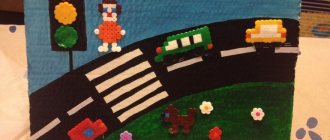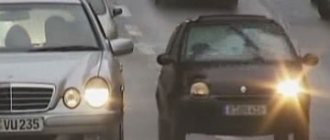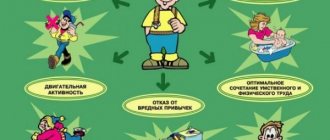Consultation for parents “We are all supposed to know the rules of the road”
Each of you wants to see your child healthy and unharmed. And everyone is sure that their smart little one will certainly not end up under the wheels of a car.
95% of accidents with children on the roads occur in situations where the children think there is no danger, or they manage to cross the road in front of vehicles, or cross the road outside the pedestrian crossing.
Every year, about 1.5 thousand children die on Russian roads, and 24 thousand are injured. And these are not just numbers. The road is a threat to children's lives.
In order for a child not to violate traffic rules, he must not only know them, he must develop the skill of safe behavior on the road. Therefore, the primary principle of parents is: “Do as I do.” A clear example from parents will be much more effective than the words “don’t run a red light” repeated hundreds of times.
Timely teach children the ability to navigate traffic situations, cultivate the need to be disciplined on the street, careful and attentive! Know that if you break traffic rules, your child will do the same!
How kids see and imagine the roadway
A child’s field of vision is narrower than that of an adult, so it is difficult for a preschooler to determine the distance to a rapidly approaching car. Moreover, the child is not able to calculate the speed of traffic.
Children of early, junior and even middle preschool age do not perceive a car as something potentially dangerous. The kid rushes after the ball that has rolled out onto the road, not thinking at all about moving cars. The main thing for the child is to return the toy. He does not understand that trying to catch the ball may be his last. Therefore, the sooner work begins on children learning the rules of the road, the greater the likelihood of saving children from harm. The teacher tells moms and dads about all this, conducting a consultation on traffic rules for parents.
What and how to tell children about traffic rules
In the second younger group, children are told and shown what a street, sidewalk, or one-way road is. Children are also introduced to types of transport (cars and trucks, buses, trolleybuses, trams), and are told about the work of a driver, traffic lights (red and green signals).
Teachers of the middle group introduce children to two-way traffic on the road, yellow traffic lights, traffic controller gestures, the “Pedestrian Crossing” road sign, ground and underground crossings, and the classification of modes of transport (water, air, land). They explain how to move along the sidewalk (on the right side) and behave in public transport.
In the senior and preparatory groups, students’ ideas about the road are expanded. Future schoolchildren are shown road signs (“Crossroads”, “Food station”, “Telephone”, “Medical assistance”, “Parking”, “Pedestrian traffic is prohibited”, “Entry is prohibited”, “Public transport stop”), and the rules are reinforced with the children crossing the roadway.
When accompanying a child, parents must comply with the following requirements:
- Leave the house early so that the child gets used to walking slowly.
- Be sure to stop before crossing the road. Cross the road at a measured pace.
- Teach children to cross the road only at pedestrian crossings.
- Never go out onto the roadway because of standing vehicles or other objects that block your view.
- When you see a tram, trolleybus, bus standing on the opposite side, do not rush, do not run.
- When going out onto the roadway, stop extraneous conversations with your child; he should get used to the need to focus his attention on the road.
- Cross the street strictly at right angles.
- Cross the road only when the traffic light is green, and first make sure that the crossing is safe.
- When crossing and at public transport stops, hold your child's hand tightly.
- Get out of the vehicle in front of the child so that the baby does not fall.
- Involve your child in monitoring the situation on the road.
- Show the safe way to kindergarten, school, store.
- Never break traffic rules in the presence of a child.
- By the time a child enters school, he must have learned and observed the following rules of behavior on the street and in transport:
- Only play away from the road.
- Cross the street where crossing signs are indicated, at intersections along the sidewalk line.
- Cross the street only at a walk, do not run.
- Watch the traffic light when crossing the street.
- When crossing the street, look first to the left, then to the right.
- Don't cross the path of oncoming traffic
- Always pass trams from the front.
- Enter any type of transport and exit it only when it is stationary.
- Do not lean out of the window of a moving vehicle.
- Get out of the car only on the right side when it has approached the sidewalk or side of the road.
- Do not ride your bicycle on the roadway.
- If you are lost on the street, don't cry. Ask an adult passerby or police officer to help.
When transporting a child by car:
- drive a car, following the rules for drivers;
- transport children in car seats;
- adults and children get into and out of the car only from the sidewalk.
Visibility
Pictures and posters “Pedestrian Reminder”, “Traffic Light”, “Be Attentive!”, “Road ABC”, etc. help children learn the rules of the road. You can buy a ready-made poster or draw it with your child at home.
Visual materials will not be useful if they hang in the room “in the background.”
Books on traffic rules for preschoolers
- The following works are recommended for reading to children of primary preschool age:
- B. Zakhoder “Chauffeur”;
- N. Kalinina “How the guys crossed the street”;
- A. Barto “Truck”, etc.
Children four to five years old are read stories by A. Dorokhov from the book “Green, Yellow, Red”, poems by V. Pishumov “Song about Rules”, S. Mikhalkov “Bad History”, V. Kozhevnikov “Traffic Light”, etc.
Pupils of the senior and preparatory groups get acquainted with the working life of S. Mikhalkov’s hero Uncle Styopa, master the gestures of a traffic controller, listening to V. Dorokhov’s story “The Influential Wand” and V. Semerin’s poem “Forbidden - Permitted”, learn to be exemplary pedestrians and responsible passengers.
Traffic rules games for preschoolers
Play is the leading activity in preschool childhood. The full development of the child, the preschooler’s mastery of vital skills and abilities, takes place precisely in it. Here are some examples of games that parents can play with their children at home.
Younger preschoolers
The purpose of the didactic game “Traffic Light” is to teach children to recognize traffic light signals. A mock-up of a traffic light with empty holes and two sets of circles in red and green are prepared in advance. The adult gives one set to the child, and keeps the other for himself.
The adult inserts one of the circles into the corresponding hole of the model and invites the child to determine which signal is on (the child picks up a circle of the same color), and also explain what the pedestrian should do (red - stand still, green - look around and walk).
Children from 4 to 5 years old
You can also play “Traffic Light” with children of this age, just add a yellow signal.
No less interesting is “Word Game”. An adult offers to clap your hands when words and phrases related to the following are heard:
- to a traffic light (standing at an intersection, standing at home, red light, blue light, yellow light, brown light, helping a pedestrian, hindering a pedestrian);
- to a pedestrian (intersection, crossing, traffic light, body, standing and waiting, steering wheel, sidewalk);
- to the driver (steering wheel, body, wing, rides, motor, flies, wheel, paws, tail);
- to the passenger (bus, trolleybus, pulls up to a stop, bed, stool, stop, shows a ticket).
Senior preschool age
The game “Guess the Sign” will help you establish the names and purposes of road signs. An adult places cardboard signs in plain sight and offers to guess the sign based on the description (in random order he talks about the purpose of the signs).
Dear parents! Remember!
The child will learn all the concepts firmly if he is introduced to the rules of the road systematically, unobtrusively. Using appropriate situations for this on the street, in the yard, on the road. When you are on the street with your baby, it is useful to explain to him everything that is happening on the road with vehicles and pedestrians. Pay attention to violators, noting that by breaking the rules they risk getting into trouble.
The child learns the laws of the street from his parents.
Don’t frighten your child on the street - panicky fear of transport is no less harmful than safety and inattention!
Only strict adherence to the Rules will guarantee the safety of you and your child!
Recommendations for parents on teaching children traffic rules. - presentation
Recommendations for parents on teaching children traffic rules
CAUSES of children's road traffic injuries insufficient adult supervision insufficient adult supervision of children's behavior; over the behavior of children; inability to predict traffic conditions; inability to predict traffic conditions; ignorance of measures to ensure safe traffic; ignorance of measures to ensure safe traffic; lack of skills to perform safe movement actions; lack of skills to perform safe movement actions; reluctance to perform safe actions, disdainful attitude towards them; reluctance to perform safe actions, disdainful attitude towards them; submission to the wrong dangerous habits of behavior on the street; submission to the wrong dangerous habits of behavior on the street; unconscious imitation of other persons (often parents) who violate traffic rules; unconscious imitation of other persons (often parents) who violate traffic rules; indiscipline, loss of vigilance. indiscipline, loss of vigilance.
The main way to develop behavioral skills in children is through observation and imitation of the behavior of adults and, above all, parents.
Recommendations for developing street behavior skills: Skill of switching to the street: Skill of switching to the street: when approaching the road, stop, look around the street in both directions. The skill of calm, confident behavior on the street: when leaving home, do not be late, leave in advance so that you have some time to spare when walking calmly. The skill of calm, confident behavior on the street: when leaving home, do not be late, leave in advance so that you have some time to spare when walking calmly. The skill of switching to self-control: the ability to monitor one’s behavior is developed daily under the guidance of parents. The skill of switching to self-control: the ability to monitor one’s behavior is developed daily under the guidance of parents. The skill of anticipating danger: the child must see with his own eyes that danger is often hidden behind various objects on the street. The skill of anticipating danger: the child must see with his own eyes that danger is often hidden behind various objects on the street.
What should adults, especially parents, teach their children? Cross the street at right angles there and when Cross the street at right angles there and when it is permitted, observe the movement of traffic it is permitted, observe the movement of traffic Walk along the street at a walk, and not run, do not rush where you need to watch and anticipate danger Walk walk along the street, not run, don’t rush where you need to watch and anticipate danger Give way to traffic, don’t try to cross the street in front of an approaching car Give way to traffic, don’t try to cross the street in front of an approaching car Understand the dangers of games and pranks on the road, have the right idea of heroism, bravery, courage Understand the danger of games and pranks on the road, have a correct idea of heroism, bravery, courage When using public transport, be extremely careful in the area of its stops When using public transport, be extremely careful in the area of its stops
When leaving the house: Leave the house in advance, so that there is a reserve of time. The child should get used to walking down the street, slowly; Leave the house in advance, so that there is a reserve of time. The child should get used to walking down the street, slowly; If there is possible movement at the entrance of the house, immediately pay attention to the child to see if there is any approaching traffic; If there is possible movement at the entrance of the house, immediately pay attention to the child to see if there is any approaching traffic; If there are vehicles parked at the entrance or trees growing, stop your movement and look around to see if there is any danger. If there are vehicles parked at the entrance or trees growing, stop your movement and look around to see if there is any danger.
When driving on the sidewalk: Keep to the right. Keep to the right. Do not lead your child along the edge of the sidewalk: an adult should always be on the side of the roadway; Do not lead your child along the edge of the sidewalk: an adult should always be on the side of the roadway; If the sidewalk is next to the road, parents should hold the child's hand; If the sidewalk is next to the road, parents should hold the child's hand; Teach your child, while walking along the sidewalk, to carefully watch cars leaving the yard; Teach your child, while walking along the sidewalk, to carefully watch cars leaving the yard; Do not teach children to go out onto the roadway. Do not teach children to go out onto the roadway.
When preparing to cross the road: Stop and look at the roadway. Develop your child's observation of the road; Stop and look at the roadway. Develop your child's observation of the road; Emphasize your movements: turning your head to inspect the road (stopping to inspect the road, stopping to let cars pass); Emphasize your movements: turning your head to inspect the road (stopping to inspect the road, stopping to let cars pass); Teach your child to peer into the distance and distinguish approaching cars; Teach your child to peer into the distance and distinguish approaching cars; Do not stand with your child on the edge of the sidewalk; Do not stand with your child on the edge of the sidewalk; Draw the child's attention to a vehicle preparing to turn, talk about the turn signal signals on cars; Draw the child's attention to a vehicle preparing to turn, talk about the turn signal signals on cars; Show how the vehicle stops at the crossing, how it moves by inertia. Show how the vehicle stops at the crossing, how it moves by inertia.
When crossing the roadway: Cross the road only at a pedestrian crossing or at an intersection; Cross the road only at a pedestrian crossing or at an intersection; Go only when the traffic light is green, even if there are no cars; Go only when the traffic light is green, even if there are no cars; When going out onto the roadway, stop talking; When going out onto the roadway, stop talking; Don’t rush, don’t run, cross the road calmly; Don’t rush, don’t run, cross the road calmly; Do not cross the street at an angle; explain to your child that this makes it harder to see the road; Do not cross the street at an angle; explain to your child that this makes it harder to see the road; Do not go out onto the roadway with your child because of vehicles or bushes without first inspecting the street; Do not go out onto the roadway with your child because of vehicles or bushes without first inspecting the street; Do not rush to cross the road, if on the other side you see friends, the right bus, teach your child that this is dangerous; Do not rush to cross the road, if on the other side you see friends, the right bus, teach your child that this is dangerous; When crossing an uncontrolled intersection, teach your child to carefully monitor the start of traffic; Explain to your child that even on a road where there are few cars, you must cross carefully, as a car may drive out of the yard or alley
When waiting for transport: stand only on landing areas, on the sidewalk or on the side of the road
When boarding and disembarking from transport: Get out first, in front of the child, otherwise the child may fall or run out onto the roadway; Get out first, in front of the child, otherwise the child may fall or run out onto the roadway; Approach the door to board only after coming to a complete stop; Approach the door to board only after coming to a complete stop; Do not get into transport at the last moment (you may get pinched by the doors); Do not get into transport at the last moment (you may get pinched by the doors); Teach your child to be careful in the stopping area - this is a dangerous place (poor view of the road, passengers can push the child onto the road). Teach your child to be careful in the stopping area - this is a dangerous place (poor view of the road, passengers can push the child onto the road).
Do not forget ! Parents were an example for children in following traffic rules
Personal example is the most intelligible form of teaching. Preserving our future, our children, ensuring their health and life is our main task.
Parents' meeting in the middle group "Children's safety on the roads"
10
Parent meeting in middle group No. 10 on the topic “Children’s safety on the road.”
Goal: Pedagogical education and involvement of parents in the process of teaching preschoolers the skills of safe behavior on the roads and streets of the city, developing a sense of responsibility for the life and health of their children.
Objectives: - To familiarize parents with the theoretical foundations of road safety. — To create motivation in parents to self-develop a culture of safe behavior for children on the streets and roads. — Create conditions for interaction with society to prevent road traffic injuries among preschool children.
Agenda for the parent meeting: 1. Opening remarks. 2. Message from the group teacher. 3. Recommendations for parents on teaching children traffic rules.
4. Distributing a handout for parents “What can I do?”
Progress of the parent meeting:
1. Opening speech by the teacher:
“Our children were born to live joyfully. To play together, to be strong friends, to give smiles to each other and flowers, so that dreams always come true in their lives.”
Yes, our children are born precisely for this, but whether this always happens, whether life will be overshadowed by tragedy - this largely depends on us, adults. The topic of today's meeting is “Children's safety on the road.” The need for a meeting on traffic rules is dictated by life itself. The terrible statistics of child mortality and health damage as a result of road accidents are simply terrifying. And most often we, the adults, are to blame for tragedies. At this meeting we will talk about what parents can do to keep their child safe on the road. First of all, parents should understand that this task of protecting their child on the road is fundamentally unsolvable. Firstly, any movement by transport (and even on your own feet) is associated with danger, and the probability of the unexpected happening is always different from zero. This was not said at all to scare parents, but on the contrary, to draw their attention to the fact that you should always take care of the children’s safety (and your own). Secondly, the task of protecting the child once and for all cannot be solved, because the child is growing, and the possible dangers that await him on the road are growing. Therefore, children should be promptly taught the ability to navigate a traffic situation, cultivate the need to be disciplined on the street, careful and prudent. And parents should not make the most common mistake - acting on the principle “you can do it with me.” If you show your child by your own example how to run to red, be sure that when left alone, he will try to repeat this trick. Dear parents! Remember, if you break the Rules, your child will do the same! We have the power to develop the skills of safe behavior on the roads, to educate a conscious and competent pedestrian, responsible for the life and health of road users.
MAGAZINE Preschooler.RF
Consultation for parents “Parents about road safety”Children, due to their age, are not always able to correctly assess the road situation and recognize danger. Do everything necessary to prevent danger from coming to your family. Timely teaching children the ability to navigate traffic situations, cultivate the need to be disciplined on the street, careful and prudent!
Remember, if you break the Rules, your child will do the same!
Teach your children the rules for safely crossing the road!
Discuss together the safest routes to travel, remind your child every day: BEFORE CROSSING THE ROAD, MAKE SURE IT IS SAFE!
Explain to your child that stopping the car right away is impossible! Learn to anticipate hidden dangers!
Discuss the safest routes together!
It is important for the child to remember that even a familiar, familiar road can be dangerous.
Dedicate a separate walk to the rules of crossing the road, check whether your child understands them correctly and knows how to use this knowledge in real traffic situations. To do this, practice crossing a pedestrian crossing together, across a one-way roadway, through controlled and uncontrolled intersections.
Walk with your child along the usual route to and from school. Talk about why it is important to walk the same path. Draw your child’s attention to all the dangers and hidden “traps” that may lie in wait for him along the way, think over the route so that it becomes safer.
Make sure that the child always has some extra time, but if the child is still late somewhere, explain to him that rushing on the road is not acceptable, and it is better to be late, but remain alive and healthy.
If you are driving a car: be sure to use a special restraint system and seat belts, buckle up yourself and make sure that the passengers in the car are buckled up. About 30% of children injured in road accidents are passengers.
During the holidays, it doesn’t matter whether your child stays in the city or leaves. It is necessary to use every opportunity to remind him of the rules of the road. Do not allow children to play near the roadway; there are closed playgrounds, stadiums, and gyms for games.
A stationary car is dangerous: it can block your view and make it difficult to notice the danger in time. You cannot go out onto the road because of parked cars. As a last resort, you need to carefully look out from behind a standing car, make sure that there is no danger, and only then cross the road.
Do not go around a stationary bus, either in front or behind!
From the stop you need to move towards the nearest pedestrian crossing. And after making sure of your safety, cross the road at a pedestrian crossing.
A slow moving car can hide behind a car going at high speed. A child often does not suspect that another car may be hidden behind one car.
It is not enough to teach children how to navigate when a traffic light is green; before you take a step onto the road, you need to make sure that cars are stopping or allowing you to pass.
On a street where cars rarely appear, children run out onto the road without first checking it and get hit by a car. Develop in your child the habit of always stopping before going out onto the road, looking around, listening, and only then crossing the street.
If you had to stop in the middle of the road, you need to be extremely careful, remember that cars are moving behind you. You cannot make a single movement without making sure it is safe.
Being next to an adult, the child relies on him and either does not watch the road at all or does not watch well. An adult does not take this into account. On the street, children are distracted by all sorts of objects and sounds, not noticing a moving car, and thinking that the way is clear, they break away from the hands of an adult and run across the road. Before crossing the road, hold your child's hand tightly.
In large cities, places of increased danger are arches and exit points from courtyards. Do not allow a child to run past a yard exit or arch ahead of an adult.
Teach children to follow traffic rules from an early age. And don’t forget that personal example is the most intelligible form of learning.
REMEMBER! The child learns the laws of the street, following the example of you, parents, and other adults. Let your example teach disciplined behavior on the street not only to your child, but also to other children.
Recommendations for parents
1. When driving on the sidewalk:
- keep to the right side of the sidewalk
- do not lead the child along the edge of the sidewalk: the adult must be on the side of the roadway
2. When preparing to cross the road:
- stop or slow down, look at the roadway
- involve your child in observing the situation on the road
- emphasize your movements: turning your head to look around the street, stopping to look around the road, stopping to let cars pass
- teach your child to recognize approaching vehicles
- do not stand with your child on the edge of the sidewalk, as when passing the vehicle can get caught, knocked down, or run over with its rear wheels
— repeatedly show your child how the vehicle stops at the crossing, how it moves by inertia.
3. When leaving home:
- immediately draw your child’s attention to the movement of vehicles at the entrance and together look to see if a car, motorcycle, moped, or bicycle is approaching you
— if there are vehicles at the entrance or trees growing that block your view, stop your movement and look around to see if there is any danger behind the obstacle.
4. When waiting for public transport:
- stand with children only on landing platforms, and if there are none, on the sidewalk or curb.
5. When crossing the roadway:
- cross the road only at pedestrian crossings or at intersections along the marked zebra line, otherwise the child will get used to crossing wherever he has to
- do not rush and do not run; always cross the road at a measured pace
- do not cross the road diagonally; Emphasize, show and tell your child every time that you are walking strictly across the street, that this is being done for better observation of cars and motor vehicles
- do not rush to cross the road if you see friends, relatives, or acquaintances on the other side. Don’t rush and don’t run towards them; instill in your child that this is dangerous.
- Don't start crossing a street where traffic rarely passes without looking around.
- Explain to your child that cars can unexpectedly leave the alley or the yard of the house
6. When boarding and disembarking from public transport:
- go out in front of the child, as the baby may fall, and an older child may run out of the parked vehicle onto the roadway
- approach the vehicle door only after a complete stop: a child, like an adult, can trip and get run over
- do not board public transport at the last moment when it departs; The front door is especially dangerous, as you can get under the wheels of a vehicle
— teach your child to be careful in the bus stop area, a particularly dangerous place for him: a stopped bus reduces the view of the road in this area.
7. When the car is moving:
- teach children to sit in the car only in the back seat; do not allow sitting next to the driver unless the front seat is equipped with a child seat
- Do not allow a small child to stand in the back seat while driving: in the event of a collision or sudden stop, he may fly over the back of the seat and hit the front window
- Do not allow children to be in the vehicle unattended.
Reminder for parents: Safe steps towards road safety.
What should parents know about their child?
At 3-4 years old, a child can distinguish a moving car from a stationary one, but he is sure that the car stops instantly.
At 6 years old - with peripheral vision he sees approximately 2/3 of what adults see; cannot determine what is moving faster: a bicycle or a sports car; does not know how to correctly distribute attention and separate the essential from the insignificant.
At 7 years old, you can more confidently distinguish the right side of the road from the left.
At 8 years old - can instantly respond to feedback, etc.; has experience of walking on the road; actively masters basic cycling skills; can determine the source of noise; establish a connection between the size of an object, its distance and time (the closer the car, the larger it is).
Educator: Amelchenko V.A.
| Next > |








